Olympus GIF 160 Instructions
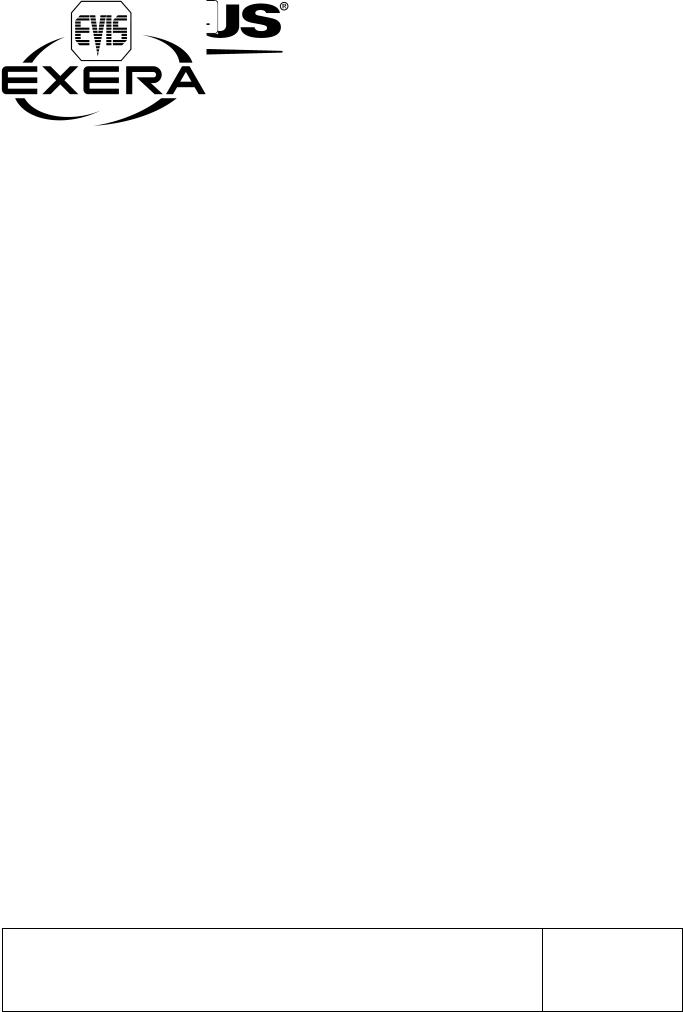
INSTRUCTIONS
EVIS EXERA GASTROINTESTINAL VIDEOSCOPE
OLYMPUS GIF TYPE XP160
OLYMPUS GIF TYPE 160
OLYMPUS GIF TYPE Q160
OLYMPUS GIF TYPE 1TQ160
OLYMPUS GIF TYPE XTQ160
EVIS EXERA COLONOVIDEOSCOPE
OLYMPUS CF TYPE Q160L/I
OLYMPUS CF TYPE Q160AL/I
OLYMPUS PCF TYPE 160AL/I
EVIS EXERA SIGMOIDOVIDEOSCOPE
OLYMPUS CF TYPE Q160S
Refer to the endoscope’s companion manual, the “REPROCESSING MANUAL” whose cover lists the model of your endoscope, for reprocessing information.
USA: CAUTION: Federal law restricts this device to sale by or on the order of a physician.

|
|
Contents |
Contents |
|
|
Symbols......................................................................................... |
|
1 |
Important Information — Please Read Before Use.................... |
2 |
|
Intended use ............................................................................................ |
2 |
|
Applicability of endoscopy and endoscopic treatment ............................. |
2 |
|
Instruction manual .................................................................................... |
3 |
|
User qualifications .................................................................................... |
3 |
|
Instrument compatibility ........................................................................... |
3 |
|
Reprocessing before the first use/reprocessing and storage after use..... |
4 |
|
Spare equipment ...................................................................................... |
4 |
|
Repair and modification ........................................................................... |
4 |
|
Signal words ............................................................................................. |
4 |
|
Warnings and cautions ............................................................................. |
5 |
|
Examples of inappropriate handling ......................................................... |
7 |
|
Chapter 1 Checking the Package Contents............................ |
9 |
|
Chapter 2 Instrument Nomenclature and Specifications ...... |
12 |
|
2.1 |
Nomenclature.................................................................................. |
12 |
2.2 |
Endoscope functions....................................................................... |
22 |
2.3 |
Specifications.................................................................................. |
24 |
Chapter 3 Preparation and Inspection .................................... |
32 |
|
3.1 |
Preparation of the equipment.......................................................... |
33 |
3.2 |
Inspection of the endoscope ........................................................... |
34 |
3.3 |
Preparation and inspection of accessories ..................................... |
39 |
3.4 |
Attaching accessories to the endoscope ........................................ |
43 |
3.5 |
Inspection and connection of ancillary equipment .......................... |
45 |
3.6 |
Inspection of the endoscopic system .............................................. |
48 |
Chapter 4 |
Operation ................................................................. |
53 |
4.1 |
Insertion .......................................................................................... |
56 |
4.2 |
Using endo-therapy accessories..................................................... |
62 |
4.3 |
Withdrawal of the endoscope.......................................................... |
67 |
4.4 |
Transportation of the endoscope .................................................... |
68 |
EVIS EXERA GIF/CF/PCF TYPE 160 Series OPERATION MANUAL |
i |

Contents
Chapter 5 |
Troubleshooting ...................................................... |
70 |
5.1 |
Troubleshooting guide .................................................................... |
70 |
5.2 |
Withdrawal of the endoscope with an abnormality.......................... |
74 |
5.3 |
Returning the endoscope for repair................................................. |
76 |
Appendix........................................................................................ |
|
77 |
System chart ............................................................................................ |
77 |
|
EMC information........................................................................................ |
92 |
|
ii |
EVIS EXERA GIF/CF/PCF TYPE 160 Series OPERATION MANUAL |
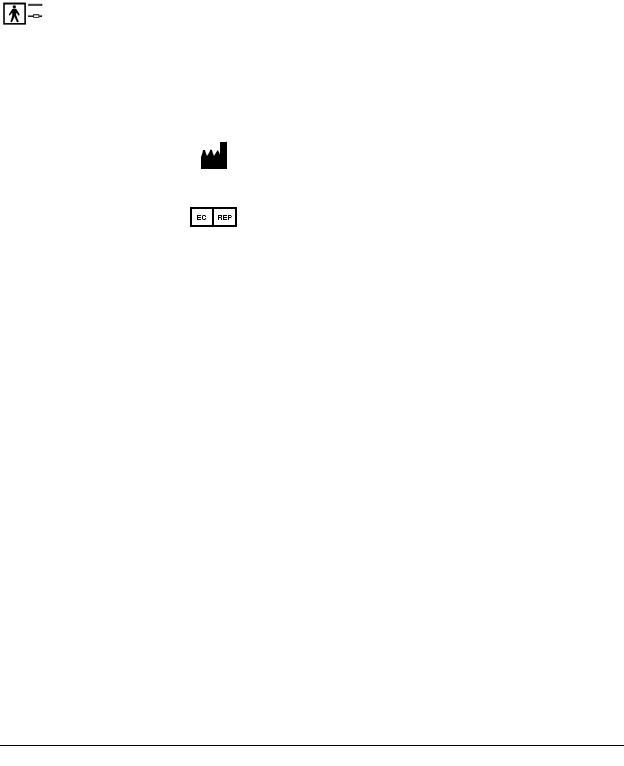
Symbols
Symbols
The meaning(s) of the symbol(s) shown on the package with the components, the back cover of this instruction manual and/or this instrument are as follows:
Refer to instructions.
Endoscope
TYPE BF applied part
Manufacturer
Authorised representative in the European Community
EVIS EXERA GIF/CF/PCF TYPE 160 Series OPERATION MANUAL |
1 |

Important Information — Please Read Before Use
Important Information — Please Read
Before Use
Intended use
These instruments have been designed to be used with an Olympus video system center, light source, documentation equipment, video monitor, endo-therapy accessories (such as a biopsy forceps) and other ancillary equipment.
Use the GIF-XP160, GIF-160, GIF-Q160, GIF-1TQ160, GIF-XTQ160 for endoscopy and endoscopic surgery within the upper digestive tract (including the esophagus, stomach and duodenum).
Use the CF-Q160L/I, CF-Q160AL/I, PCF-160AL/I for endoscopy and endoscopic surgery within the lower digestive tract (including the anus, rectum, sigmoid colon, colon and ileocecal valve).
Use the CF-Q160S for endoscopy and endoscopic surgery within the lower digestive tract (including the anus, rectum and sigmoid colon).
Do not use these instruments for any purpose other than their intended uses.
Applicability of endoscopy and endoscopic treatment
If there is an official standard on the applicability of endoscopy and endoscopic treatment that is defined by the hospital’s administration or other official institutions such as academic societies on endoscopy, follow that standard. Before starting endoscopy and endoscopic treatment, thoroughly evaluate its properties, purposes, effects, and possible risk (their natures, extent and probability). Perform endoscopy and endoscopic treatment only when its potential benefits are greater than its risks.
Fully explain to the patient the potential benefits and risks of the endoscopy and endoscopic treatment as well as any examination/treatment methods that can be performed in its place, and perform the endoscopy and endoscopic treatment only after obtaining the consent of the patient.
Even after starting the endoscopy and endoscopic treatment, continue to evaluate the potential benefits and risks, and immediately stop the endoscopy/treatment and take proper measures if the risks to the patient become greater than the potential benefits.
2 |
EVIS EXERA GIF/CF/PCF TYPE 160 Series OPERATION MANUAL |

Important Information — Please Read Before Use
Instruction manual
This instruction manual contains essential information on using this instrument safely and effectively. Before use, thoroughly review this manual and the manuals of all equipment which will be used during the procedure and use the equipment as instructed.
Note that the complete instruction manual set for this endoscope consists of this manual and the “REPROCESSING MANUAL” whose cover lists the model of your endoscope. It also accompanied the endoscope at shipment.
Keep this and all related instruction manuals in a safe, accessible location.
If you have any questions or comments about any information in this manual, please contact Olympus.
User qualifications
The operator of this instrument must be a physician or medical personnel under the supervision of a physician and must have received sufficient training in clinical endoscopic technique. This manual, therefore, does not explain or discuss clinical endoscopic procedures. For details on the clinical endoscopic procedures, the physician and operator are requested to form judgments from their viewpoints as specialists.
Instrument compatibility
Refer to the “System chart” in the Appendix to confirm that this instrument is compatible with the ancillary equipment being used. Using incompatible equipment can result in patient or operator injury and/or equipment damage.
This instrument complies with EMC standard for medical electrical equipment; edition 2 (IEC 60601-1-2: 2001). However, when connected with an instrument that complies with EMC standard for medical electrical equipment; edition 1 (IEC 60601-1-2: 1993), the whole system complies with edition 1.
EVIS EXERA GIF/CF/PCF TYPE 160 Series OPERATION MANUAL |
3 |
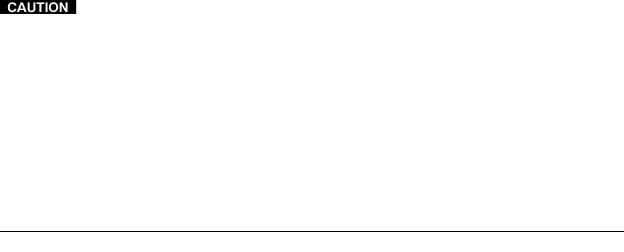
Important Information — Please Read Before Use
Reprocessing before the first use/reprocessing and storage after use
This instrument was not cleaned, disinfected or sterilized before shipment. Before using this instrument for the first time, reprocess it according to the instructions given in the endoscope’s companion manual, the “REPROCESSING MANUAL” whose cover lists the model of your endoscope.
After using this instrument, reprocess and store it according to the instructions given in the endoscope’s companion reprocessing manual. Improper and/or incomplete reprocessing or storage can present an infection control risk, cause equipment damage or reduce performance.
Spare equipment
Be sure to prepare another endoscope to avoid that the examination will be interrupted due to equipment failure or malfunction.
Repair and modification
This instrument does not contain any user-serviceable parts. Do not disassemble, modify or attempt to repair it; patient or operator injury and/or equipment damage can result. This instrument is to be repaired by Olympus technicians only.
Signal words
The following signal words are used throughout this manual:
Indicates a potentially hazardous situation which, if not avoided, could result in death or serious injury.
Indicates a potentially hazardous situation which, if not avoided, may result in minor or moderate injury. It may also be used to alert against unsafe practices or potential equipment damage.
4 |
EVIS EXERA GIF/CF/PCF TYPE 160 Series OPERATION MANUAL |

Important Information — Please Read Before Use
Indicates additional helpful information.
Warnings and cautions
Follow the warnings and cautions given below when handling this instrument. This information is to be supplemented by the warnings and cautions given in each chapter.
•After using this instrument, reprocess and store it according to the instructions given in the endoscope’s companion reprocessing manual. Using improperly or incompletely reprocessed or stored instruments may cause patient cross-contamination and/or infection.
•Do not strike, bend, hit, pull, twist, or drop the endoscope’s distal end, insertion tube, bending section, control section, universal cord, or endoscope connector of the endoscope with excessive force. The endoscope may be damaged and could cause patient injury, burns, bleeding and/or perforations. It could also cause parts of the endoscope to fall off inside the patient.
•Never perform angulation control forcibly or abruptly. Never forcefully pull, twist or rotate the angulated bending section. Patient injury, bleeding and/or perforation can result. It may also become impossible to straighten the bending section during an examination.
•Never insert or withdraw the endoscope’s insertion tube while the bending section is locked in position. Patient injury can result.
•Do not touch the light guide of the endoscope connector immediately after removing it from the light source because it is extremely hot. Operator or patient burns can result.
•Never perform flexibility adjustment, operate the bending section, feed air or perform suction, insert or withdraw the endoscope’s insertion tube without viewing the endoscopic image. Never use endo-therapy accessories without viewing the endoscopic image. Patient injury can result.
EVIS EXERA GIF/CF/PCF TYPE 160 Series OPERATION MANUAL |
5 |

Important Information — Please Read Before Use
•Never perform flexibility adjustment, operate the bending section, feed air or perform suction, insert or withdraw the endoscope’s insertion tube while the image is frozen. Never use endo-therapy accessories while the image is frozen. Patient injury can result.
•Regardless of the flexibility of the endoscope’s insertion tube, never insert or withdraw it with excessive force. Otherwise, patient injury could result.
•Do not pull the universal cord during an examination. The endoscope connector will be pulled out from the output socket of the light source and the endoscopic image will not be visible.
•Do not coil the insertion tube or universal cord into a diameter of less than 12 cm. Equipment damage can result.
•Do not touch the electrical contacts inside the electrical connector. CCD damage may result.
•Do not apply shock to the distal end of the insertion tube, particularly the objective lens surface at the distal end. Visual abnormalities may result.
•Do not twist or bend the bending section with your hands. Equipment damage may result.
•Do not squeeze the bending section forcefully. The covering of the bending section may stretch or break and cause water leaks.
•Turn the video system center OFF before connecting or disconnecting the videoscope cable from the electrical connector on the endoscope. Turn the switch ON or OFF only when the videoscope cable is connected to both the video system center and electrical connector on the endoscope. Failure to do so can result in equipment damage, including destruction of the CCD.
•The endoscope’s remote switches cannot be removed from the control section. Pressing, pulling or twisting them with excessive force can break the switches and/or may cause water leaks.
6 |
EVIS EXERA GIF/CF/PCF TYPE 160 Series OPERATION MANUAL |
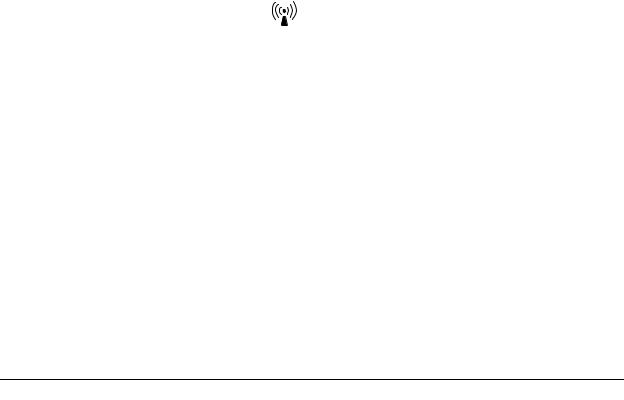
Important Information — Please Read Before Use
•If remote switch 1 does not return to the OFF position after being pressed strongly from the side, gently pull the switch upwards to return it to the OFF position.
•Do not hit or bend the electrical contacts on the endoscope connector. The connection to the light source may be impaired and faulty contact can result.
•Do not attempt to bend the endoscope’s insertion tube with excessive force. Otherwise, the insertion tube may be damaged.
•Do not attempt to bend the endoscope’s insertion tube with excessive force unless flexibility is at the stiffest position. Otherwise, the insertion tube may be damaged.
•The endoscope contains a memory chip that stores information about the endoscope and communicates this information to the CV-160. Although the memory chip is durable, damage will prevent data from being backed up on it. When data are lost or damaged, contact Olympus.
•Electromagnetic interference may occur on this instrument near equipment marked with the following symbol or other portable and mobile RF (Radio Frequency) communications equipment such as cellular phones. If electromagnetic interference occurs, mitigation measures may be necessary, such as reorienting or relocating this instrument, or shielding the location.
Examples of inappropriate handling
Details on clinical endoscopic technique are the responsibility of trained specialists. Patient safety in endoscopic examinations and endoscopic treatment can be ensured through appropriate handling by the physician and the medical facility. Examples of inappropriate handling are given below;
•Over-insufflating the lumen may cause patient pain and/or perforation.
•Applying prolonged suction with the distal end in contact with the mucosal surface may cause bleeding or suction lesions.
•Retroflexing the endoscope within the esophagus or duodenal bulb may cause mucosal trauma or impaction of the endoscope (for GIF models only).
EVIS EXERA GIF/CF/PCF TYPE 160 Series OPERATION MANUAL |
7 |

Important Information — Please Read Before Use
•Inserting, withdrawing and using endo-therapy accessories without a clear endoscopic image may cause burns or perforation.
•Inserting or withdrawing the endoscope, feeding air, applying suction or operating the bending section without a clear endoscopic image may cause patient injury.
8 |
EVIS EXERA GIF/CF/PCF TYPE 160 Series OPERATION MANUAL |
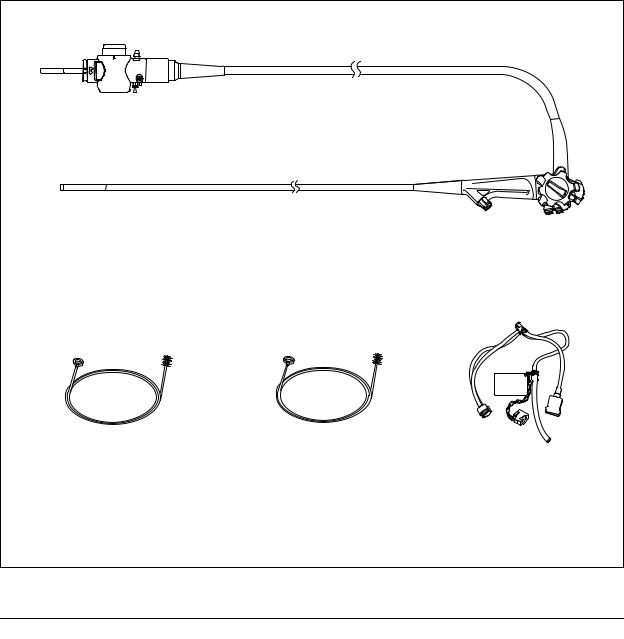
Chapter 1 Checking the Package Contents
Chapter 1 Checking the Package
Contents
Match all items in the package with the components shown below. Inspect each item for damage. If the instrument is damaged, a component is missing or you have any questions, do not use the instrument; immediately contact Olympus. This instrument was not disinfected or sterilized before shipment.
Before using this instrument for the first time, reprocess it according to the instructions given in the endoscope’s companion manual, the “REPROCESSING MANUAL” whose cover lists the model of your endoscope.
Endoscope
Channel cleaning brush |
Channel cleaning brush |
|
(BW-20T) |
(BW-17K for GIF-XTQ160 only) |
Injection tube (MH-946) |
EVIS EXERA GIF/CF/PCF TYPE 160 Series OPERATION MANUAL |
9 |
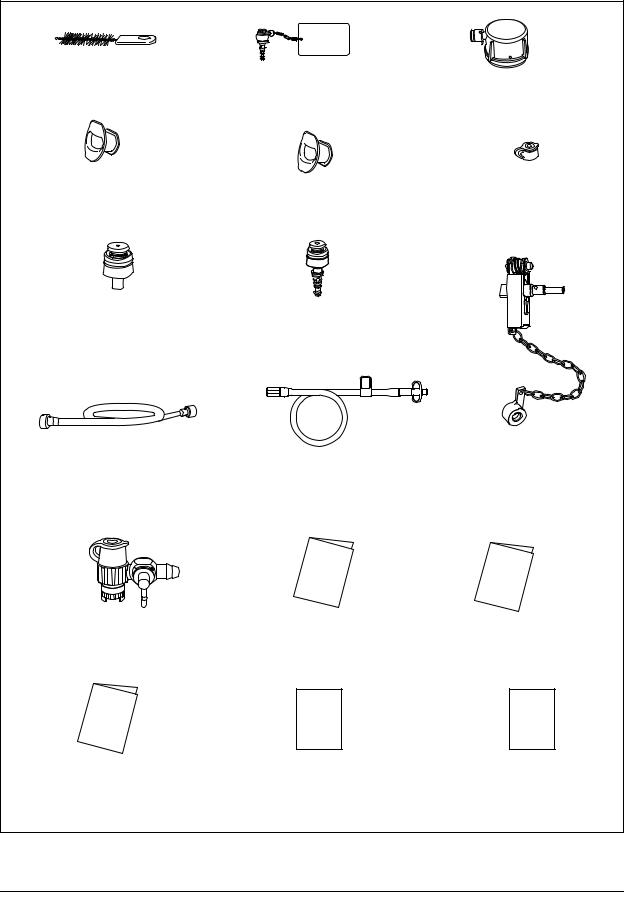
Chapter 1 Checking the Package Contents
Channel-opening cleaning brush (MH-507)
Mouthpiece (MA-474, MB-142 for
GIF-XP160, 1 pc. each)
Suction valve (MH-443, 2 pcs.)
Suction cleaning adapter (MH-856)
AW channel cleaning adapter (MH-948)
Mouthpiece (MB-142 for GIF-160, GIF-Q160, GIF-1TQ160, GIF-XTQ160, 2 pcs.)
Air/water valve (MH-438, 2 pcs.)
Auxiliary water tube (MAJ-855 for endoscopes with auxiliary water feeding only)
Water-resistant cap (MH-553)
Biopsy valve (MB-358, 10 pcs.)
Channel plug (MH-944)
Forceps Suction Plug (T-Plug) |
Operation manual |
Reprocessing manual |
|
(MH-405 for GIF-XTQ160 only) |
|||
|
|
Instruction Manual |
Instructions (Leaflet type, for |
Instructions |
(Forceps Suction Plug, |
CF-Q160AL/I, PCF-160AL/I only) |
(Leaflet type, for |
for GIF-XTQ160 only) |
|
GIF-XTQ160 only) |
10 |
EVIS EXERA GIF/CF/PCF TYPE 160 Series OPERATION MANUAL |

Chapter 1 Checking the Package Contents
EVIS EXERA GIF/CF/PCF TYPE 160 Series OPERATION MANUAL |
11 |

Chapter 2 Instrument Nomenclature and Specifications
Chapter 2 Instrument Nomenclature
and Specifications
2.1Nomenclature
GIF-XP160, GIF-160, GIF-Q160
Universal cord
|
1. Suction connector |
5. Electrical connector |
2. S-cord connector mount |
Air pipe
3. Air supply connector
3. Water supply connector
Light guide
Product name and serial number Electrical contacts
4. Endoscope connector
12 |
EVIS EXERA GIF/CF/PCF TYPE 160 Series OPERATION MANUAL |
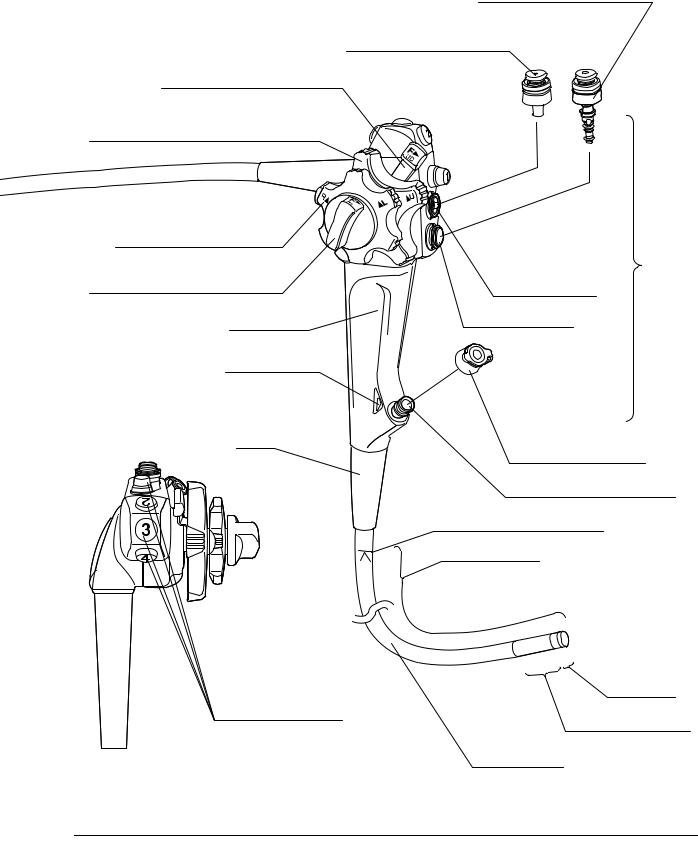
Chapter 2 Instrument Nomenclature and Specifications
7.UP/DOWN angulation lock
6.UP/DOWN angulation control knob
16.RIGHT/LEFT angulation control knob
15. RIGHT/LEFT angulation lock
Grip section
14. Color code
Boot
13. Remote switches
Top view
9.Air/water valve (MH-438)
8.Suction valve (MH-443)
Control section
Suction cylinder Air/water cylinder
Biopsy valve (MB-358)
10.Instrument channel port
11.Insertion tube limit mark
Working length
Distal end
12. Bending section
Insertion tube
EVIS EXERA GIF/CF/PCF TYPE 160 Series OPERATION MANUAL |
13 |
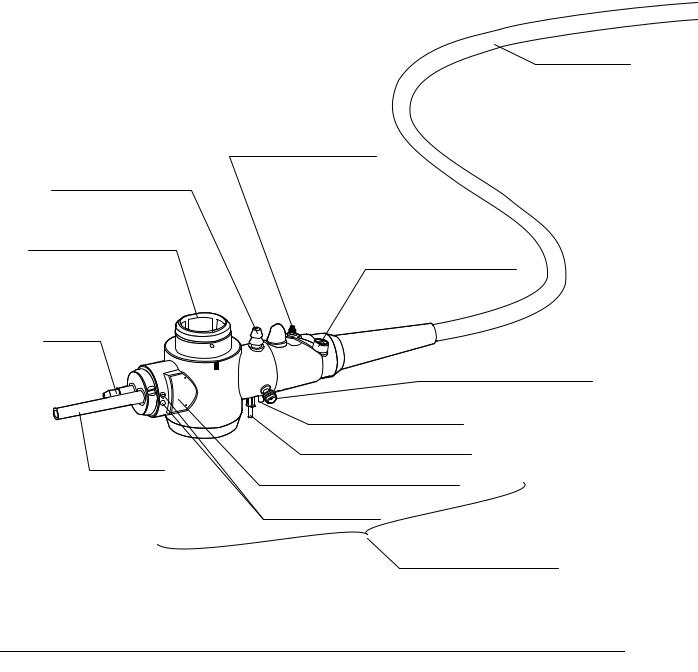
Chapter 2 Instrument Nomenclature and Specifications
GIF-1TQ160, CF-Q160L/I, CF-Q160S
1.Suction connector
5.Electrical connector
Air pipe
Light guide
Universal cord
17. Auxiliary water inlet
Auxiliary water inlet cap (MAJ-215)
2. S-cord connector mount
3. Air supply connector
3. Water supply connector Product name and serial number
Electrical contacts
4. Endoscope connector
14 |
EVIS EXERA GIF/CF/PCF TYPE 160 Series OPERATION MANUAL |
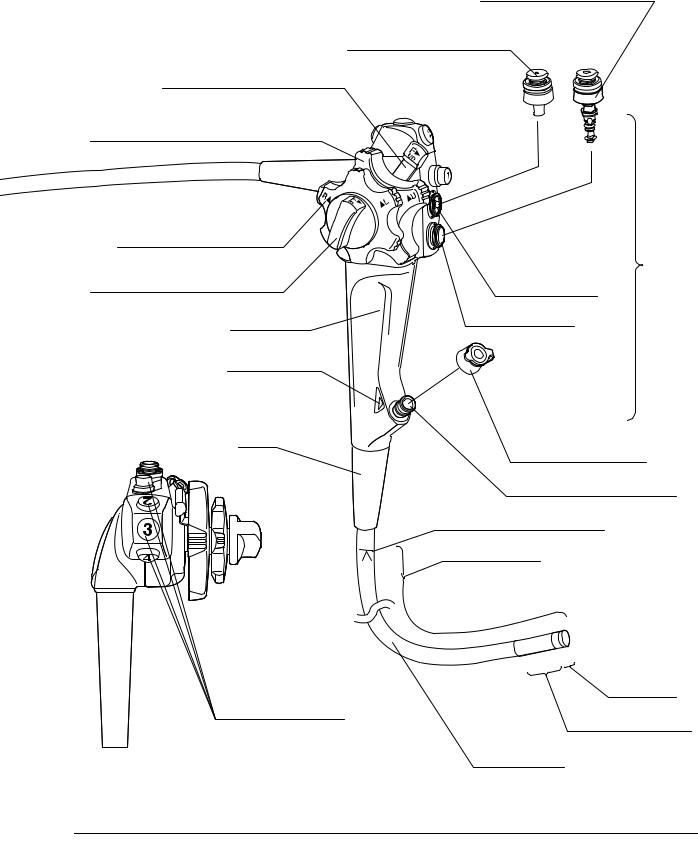
Chapter 2 Instrument Nomenclature and Specifications
7.UP/DOWN angulation lock
6.UP/DOWN angulation control knob
16.RIGHT/LEFT angulation control knob
15. RIGHT/LEFT angulation lock
Grip section
14. Color code
Boot
13. Remote switches
Top view
9.Air/water valve (MH-438)
8.Suction valve (MH-443)
Control section
Suction cylinder Air/water cylinder
Biopsy valve (MB-358)
10.Instrument channel port
11.Insertion tube limit mark
Working length
Distal end
12. Bending section
Insertion tube
EVIS EXERA GIF/CF/PCF TYPE 160 Series OPERATION MANUAL |
15 |
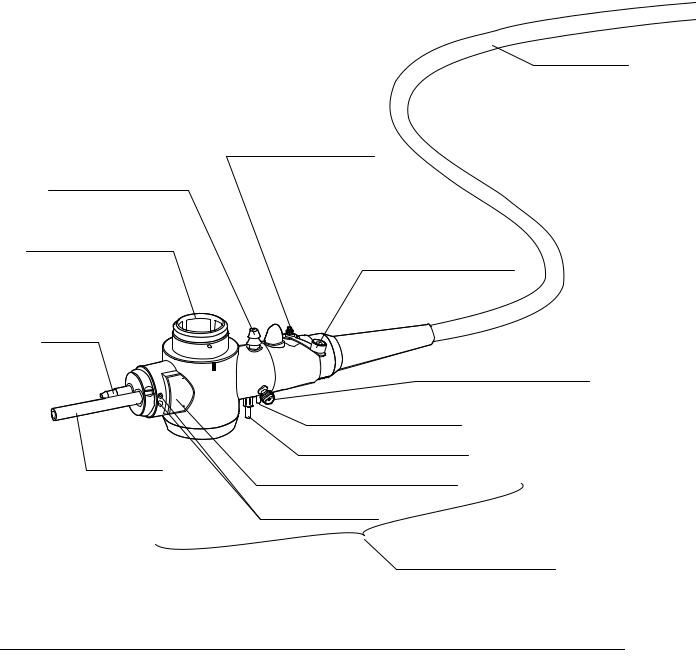
Chapter 2 Instrument Nomenclature and Specifications
GIF-XTQ160
1.Suction connector
5.Electrical connector
Air pipe
Light guide
Universal cord
17. Auxiliary water inlet
Auxiliary water inlet cap (MAJ-215)
2. S-cord connector mount
3. Air supply connector
3. Water supply connector Product name and serial number
Electrical contacts
4. Endoscope connector
16 |
EVIS EXERA GIF/CF/PCF TYPE 160 Series OPERATION MANUAL |
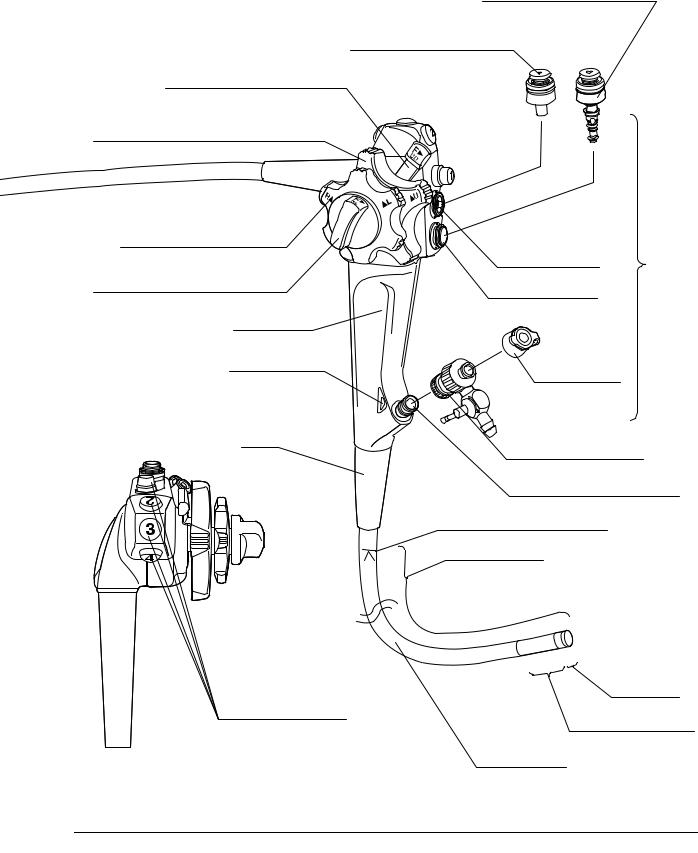
Chapter 2 Instrument Nomenclature and Specifications
7.UP/DOWN angulation lock
6.UP/DOWN angulation control knob
16.RIGHT/LEFT angulation control knob
15. RIGHT/LEFT angulation lock
Grip section
14. Color code
Boot
13. Remote switches
Top view
9.Air/water valve (MH-438)
8.Suction valve (MH-443)
Suction cylinder |
Control |
|
section |
Air/water cylinder |
|
Biopsy valve |
|
(MB-358) |
|
Forceps Suction Plug (T-Plug) (MH-405)
10.Instrument channel port
11.Insertion tube limit mark
Working length
Distal end
12. Bending section
Insertion tube
EVIS EXERA GIF/CF/PCF TYPE 160 Series OPERATION MANUAL |
17 |

Chapter 2 Instrument Nomenclature and Specifications
CF-Q160AL/I
1.Suction connector
5.Electrical connector
Air pipe
Light guide
Universal cord
17. Auxiliary water inlet
Auxiliary water inlet cap (MAJ-215)
2. S-cord connector mount
3.Air supply connector
3.Water supply connector Product name and serial number
Electrical contacts
4. Endoscope connector
18 |
EVIS EXERA GIF/CF/PCF TYPE 160 Series OPERATION MANUAL |
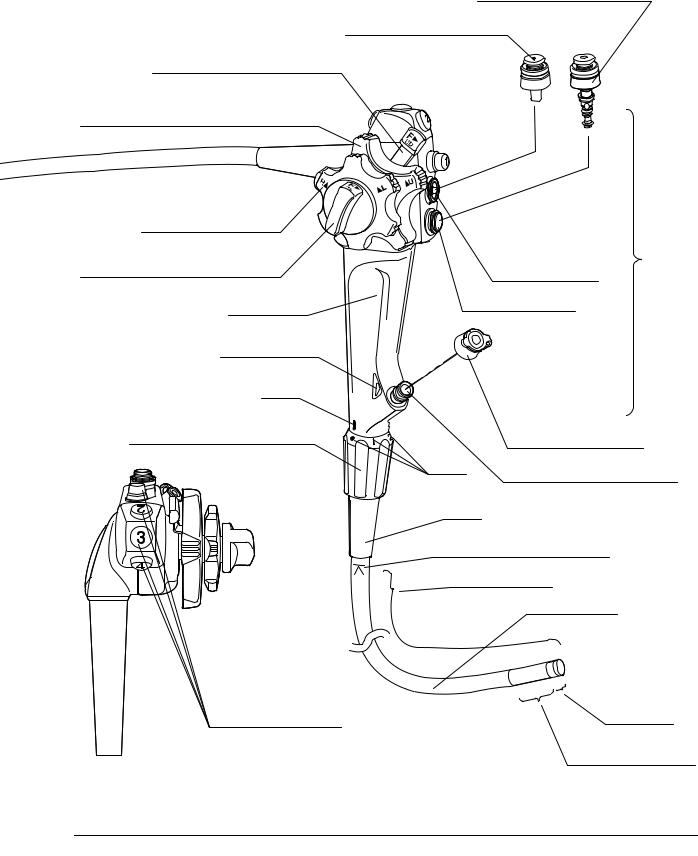
Chapter 2 Instrument Nomenclature and Specifications
7. UP/DOWN angulation lock
6.UP/DOWN angulation control knob
16.RIGHT/LEFT angulation control knob
15. RIGHT/LEFT angulation lock
Grip section
14. Color code
Mark
18. Flexibility adjustment ring
9.Air/water valve (MH-438)
8.Suction valve (MH-443)
Suction cylinder
Air/water cylinder
Biopsy valve (MB-358)
Mark 10. Instrument channel
Boot
11.Insertion tube limit mark Working length
Insertion tube
Control section
port
13. Remote switches |
Distal end |
12. Bending section
Top view
EVIS EXERA GIF/CF/PCF TYPE 160 Series OPERATION MANUAL |
19 |
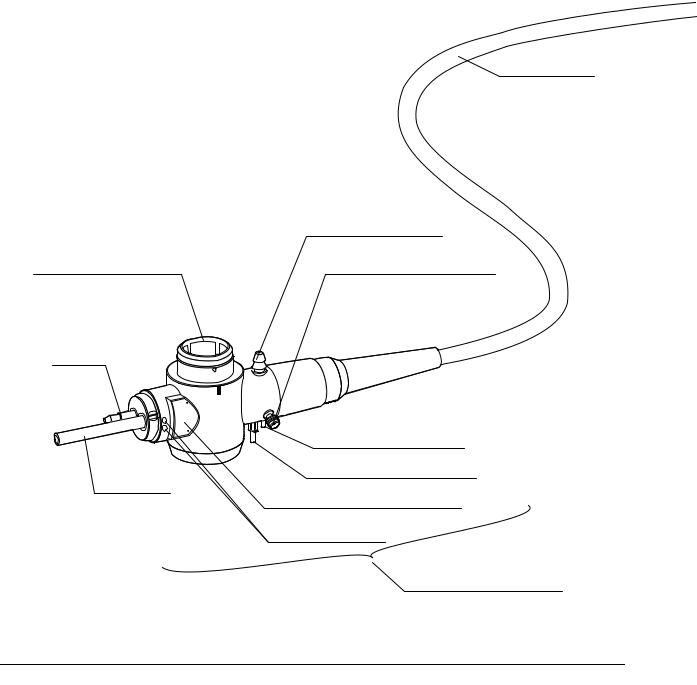
Chapter 2 Instrument Nomenclature and Specifications
PCF-160AL/I
Universal cord
1. Suction connector
5. Electrical connector |
2. S-cord connector mount |
Air pipe
3. Air supply connector
3. Water supply connector
Light guide
Product name and serial number Electrical contacts
4. Endoscope connector
20 |
EVIS EXERA GIF/CF/PCF TYPE 160 Series OPERATION MANUAL |
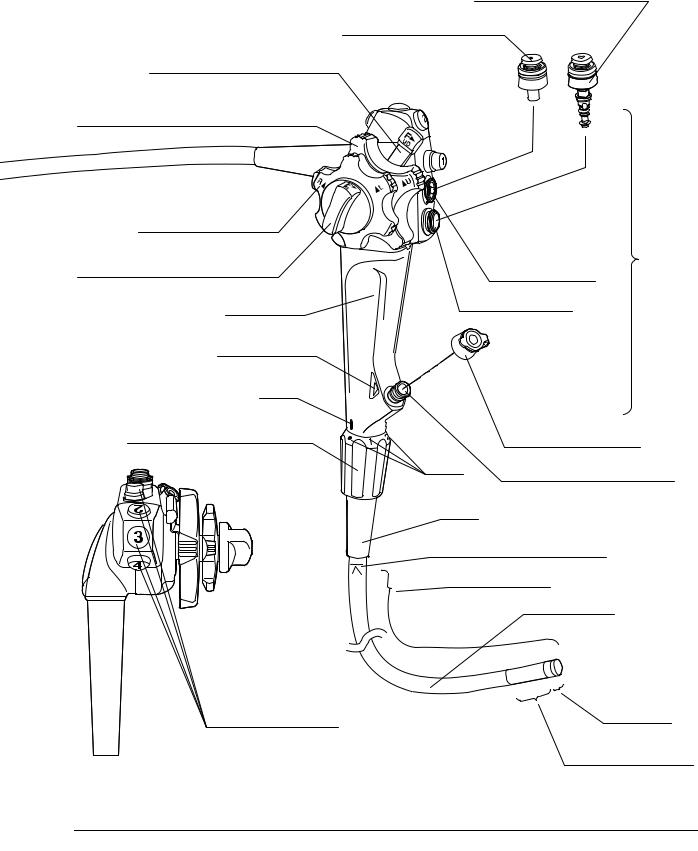
Chapter 2 Instrument Nomenclature and Specifications
7. UP/DOWN angulation lock
6.UP/DOWN angulation control knob
16.RIGHT/LEFT angulation control knob
15. RIGHT/LEFT angulation lock
Grip section
14. Color code
Mark
18. Flexibility adjustment ring
9.Air/water valve (MH-438)
8.Suction valve (MH-443)
Suction cylinder
Air/water cylinder
Mark
Boot
11. Insertion tube limit mark Working length
Insertion tube
Control section
13. Remote switches |
Distal end |
12. Bending section
Top view
EVIS EXERA GIF/CF/PCF TYPE 160 Series OPERATION MANUAL |
21 |

Chapter 2 Instrument Nomenclature and Specifications
2.2Endoscope functions
1.Suction connector
This connector connects the endoscope to the suction tube of the suction pump.
2.S-cord connector mount
This mount connects the endoscope with the Olympus electrosurgical unit via the S-cord. The S-cord conducts leakage current from the endoscope to the electrosurgical unit. To connect the S-cord, refer to the instruction manual for the electrosurgical unit.
3.Water supply connector and air supply connector
These connectors connect the endoscope to the water container via the water container tube, to supply water to the distal end of the endoscope.
4.Endoscope connector
This connector connects the endoscope to the output socket of the light source and transmits light from the light source to the endoscope.
5.Electrical connector
This connector connects the endoscope to the video system center via the videoscope cable. The endoscope contains a memory chip that stores information about the endoscope and communicates this information to the video system center CV-160. For more details, refer to the instruction manual of the CV-160.
6.UP/DOWN angulation control knob
When this knob is turned in the “ U” direction, the bending section moves UP; when the knob is turned in the “D
U” direction, the bending section moves UP; when the knob is turned in the “D ” direction, the bending section moves DOWN.
” direction, the bending section moves DOWN.
7.UP/DOWN angulation lock
Moving this lock in the “F ” direction frees angulation. Moving the lock in the opposite direction locks the bending section at any desired position.
” direction frees angulation. Moving the lock in the opposite direction locks the bending section at any desired position.
8.Suction valve (MH-443)
This valve is depressed to activate suction. The valve is used to remove any fluid, debris, flatus or air from the patient.
9.Air/water valve (MH-438)
The hole in this valve is covered to insufflate air and the valve is depressed to feed water for lens washing. It also can be used to feed air to remove any fluid or debris adhering to the objective lens.
22 |
EVIS EXERA GIF/CF/PCF TYPE 160 Series OPERATION MANUAL |

Chapter 2 Instrument Nomenclature and Specifications
10.Instrument channel port
The instrument channel port functions as:
−channel for the insertion of endo-therapy accessories
−suction channel
−fluid feed channel (from a syringe via the biopsy valve)
11.Insertion tube limit mark
This mark shows the maximum point to which the endoscope may be inserted into the patient’s body.
12.Bending section
This section moves the distal end of the endoscope when the UP/DOWN and RIGHT/LEFT angulation control knobs are operated.
13.Remote switches 1 to 4
The functions of the remote switches 1 to 4 can be selected on the video system center. When selecting the functions, refer to the instruction manual for the video system center.
14.Color code
This code is used to quickly determine the compatibility of endo-therapy accessories. The endoscope can be used with endo-therapy accessories that have the same color code.
• Blue: |
GIF-XP160 |
• Yellow: |
GIF-160, GIF-Q160, PCF-160AL/I |
• Orange: |
GIF-1TQ160, GIF-XTQ160, CF-Q160L/I/S, |
|
CF-Q160AL/I |
15.RIGHT/LEFT angulation lock
Turning this lock in the “F ” direction frees angulation. Turning the lock in the opposite direction locks the bending section at any desired position.
” direction frees angulation. Turning the lock in the opposite direction locks the bending section at any desired position.
16.RIGHT/LEFT angulation control knob
When this knob is turned in the “R ” direction, the bending section moves RIGHT; when the knob is turned in the “
” direction, the bending section moves RIGHT; when the knob is turned in the “ L” direction, the bending section moves LEFT.
L” direction, the bending section moves LEFT.
17.Auxiliary water inlet (for endoscopes with auxiliary water feeding only)
This inlet is connected to the auxiliary water tube. Feed water from this inlet through the auxiliary water channel when necessary, (e.g. when blood adheres to mucosa in the patient’s body cavity). When the auxiliary water inlet is not being used, make sure that it is covered by the auxiliary water inlet cap.
EVIS EXERA GIF/CF/PCF TYPE 160 Series OPERATION MANUAL |
23 |

Chapter 2 Instrument Nomenclature and Specifications
18.Flexibility adjustment ring (for CF-Q160AL/I, PCF-160AL/I only)
Turn this ring to adjust the flexibility of the insertion tube.
When the “z” mark on the ring is aligned with the “  ” mark at the bottom of the grip section, the insertion tube has the softest condition. To decrease the
” mark at the bottom of the grip section, the insertion tube has the softest condition. To decrease the
flexibility, turn the ring so that the numbers are aligned with the “  ” mark (“3” corresponds to the stiffest condition). In the section between “z” and “3”, insertion tube flexibility can be changed gradually regardless of the positions of other index markings (“1” and “2”).
” mark (“3” corresponds to the stiffest condition). In the section between “z” and “3”, insertion tube flexibility can be changed gradually regardless of the positions of other index markings (“1” and “2”).
2.3Specifications
Operating environment
Operating |
Ambient temperature |
10 |
– 40°C (50 – 104°F) |
|
environment |
|
|
|
|
Relative humidity |
30 |
– 85% |
||
|
||||
|
|
|
||
|
Atmospheric |
700 – 1060 hPa |
||
|
pressure |
(0.7 – 1.1 kgf/cm2) |
||
|
|
(10.2 – 15.4 psia) |
||
|
|
|
|
|
24 |
EVIS EXERA GIF/CF/PCF TYPE 160 Series OPERATION MANUAL |

Chapter 2 Instrument Nomenclature and Specifications
Specifications
Endoscope functions
Model |
|
GIF-XP160 |
|||
|
|
|
|
|
|
Optical |
Field of view |
|
120° |
|
|
system |
|
|
|
|
|
Direction of view |
Forward viewing |
||||
|
|||||
|
|
|
|||
|
Depth of field |
3 – 100 mm |
|||
|
|
|
|
|
|
Insertion tube |
Distal end outer |
ø 5.9 mm |
|||
|
diameter |
||||
|
|
|
|
||
|
|
|
|
||
|
Distal end enlarged |
1. Air/water nozzle |
|
||
|
|
2. Light guide lens |
|
||
|
|
3. Objective lens |
|
|
|
|
|
4. Instrument channel outlet |
|||
|
|
3. |
UP |
1. |
|
|
|
|
|||
|
|
RIGHT |
|
LEFT |
|
|
|
2. |
|
4. |
|
|
|
|
DOWN |
|
|
|
|
|
|
|
|
|
Insertion tube outer |
ø 5.9 mm |
|||
|
diameter |
||||
|
|
|
|
||
|
|
|
|||
|
Working length |
1030 mm |
|||
|
|
|
|
|
|
Instrument |
Channel inner |
|
ø 2 mm |
|
|
channel |
diameter |
|
|
||
|
|
|
|||
|
|
|
|
|
|
|
Minimum visible |
3 mm from the distal end |
|||
|
distance |
||||
|
|
|
|
||
|
|
|
|
|
|
|
Direction from which |
|
|
|
|
|
endo-therapy |
|
|
|
|
|
accessories enter |
|
|
|
|
|
and exit the |
|
|
|
|
|
endoscopic image |
|
|
|
|
|
|
|
|
||
Air flow rate |
|
25 cm3/s |
|
||
|
|
Note: Standard when CLV-160 (high air |
|||
|
|
pressure) is used. |
|
|
|
|
|
|
|||
Bending |
Angulation range |
UP 180°, DOWN 90°, |
|||
section |
|
RIGHT 100°, LEFT 100° |
|||
|
|
|
|||
Total length |
|
1345 mm |
|||
|
|
|
|
|
|
EVIS EXERA GIF/CF/PCF TYPE 160 Series OPERATION MANUAL |
25 |
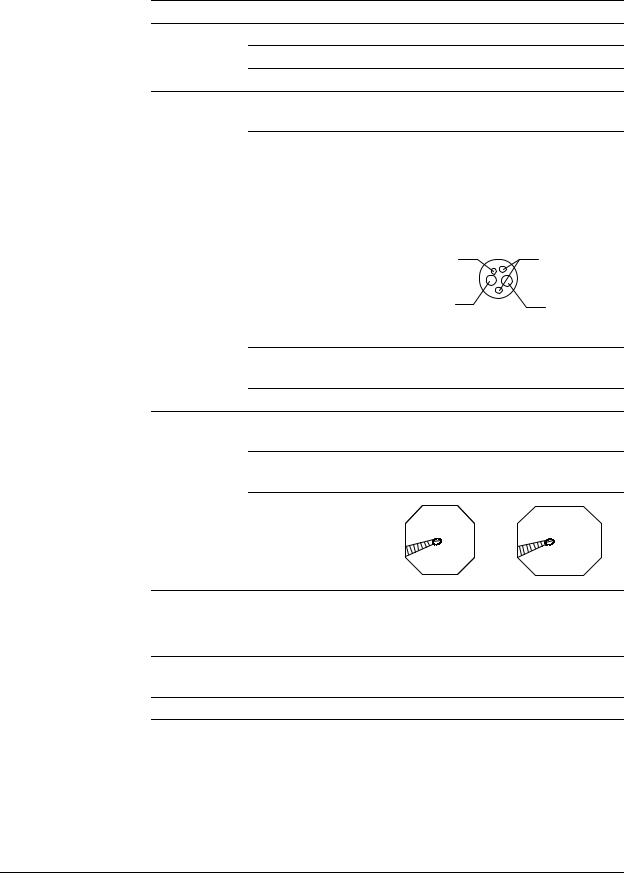
Chapter 2 Instrument Nomenclature and Specifications
Model |
|
GIF-160 |
GIF-Q160 |
Optical |
Field of view |
|
140° |
system |
Direction of view |
Forward viewing |
|
|
|||
|
Depth of field |
3 – 100 mm |
|
Insertion tube |
Distal end outer |
ø 8.6 mm |
ø 9.8 mm |
|
diameter |
||
|
|
|
|
|
Distal end enlarged |
1. Air/water nozzle |
|
|
|
2. Light guide lens |
|
|
|
3. Objective lens |
|
|
|
4. Instrument channel outlet |
|
|
|
1. |
UP |
|
|
2. |
|
|
|
RIGHT |
LEFT |
|
|
3. |
4. |
|
|
|
DOWN |
|
Insertion tube outer |
ø 8.6 mm |
ø 9.5 mm |
|
diameter |
||
|
|
|
|
|
Working length |
|
1030 mm |
Instrument |
Channel inner |
|
ø 2.8 mm |
channel |
diameter |
|
|
|
|
||
|
Minimum visible |
3 mm from the distal end |
|
|
distance |
||
|
|
|
|
|
Direction from which |
|
|
|
endo-therapy |
|
|
|
accessories enter |
|
|
|
and exit the |
|
|
|
endoscopic image |
|
|
Air flow rate |
|
|
25 cm3/s |
|
|
Note: Standard when CLV-160 (high air |
|
|
|
pressure) is used. |
|
Bending |
Angulation range |
UP 210°, DOWN 90°, |
|
section |
|
RIGHT 100°, LEFT 100° |
|
Total length |
|
|
1345 mm |
26 |
EVIS EXERA GIF/CF/PCF TYPE 160 Series OPERATION MANUAL |
